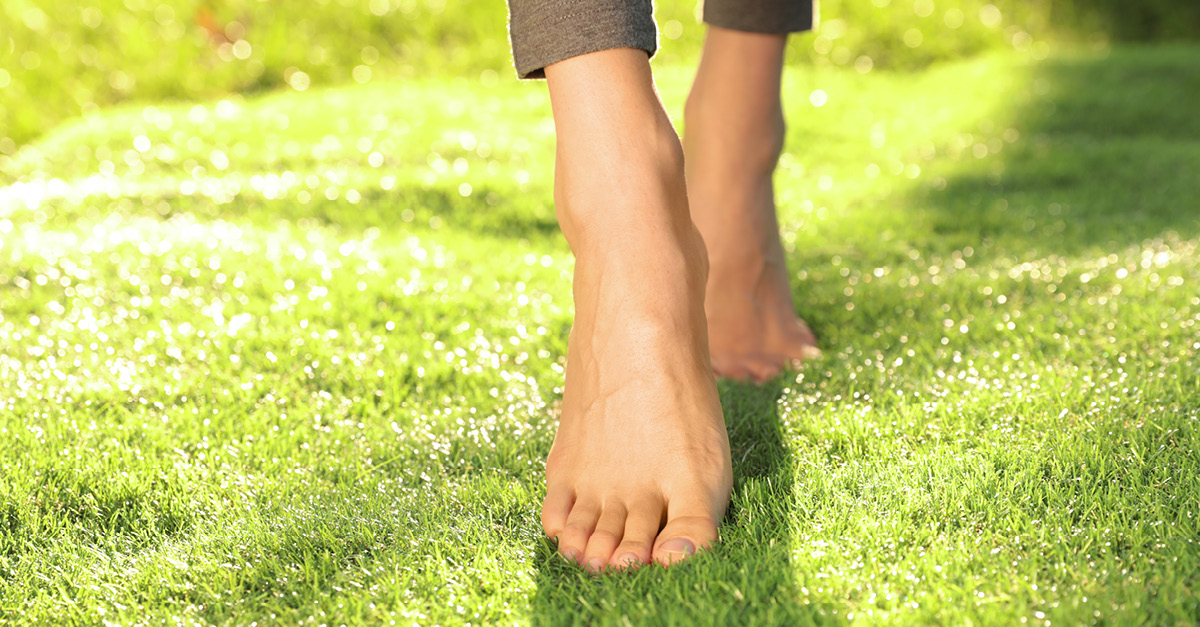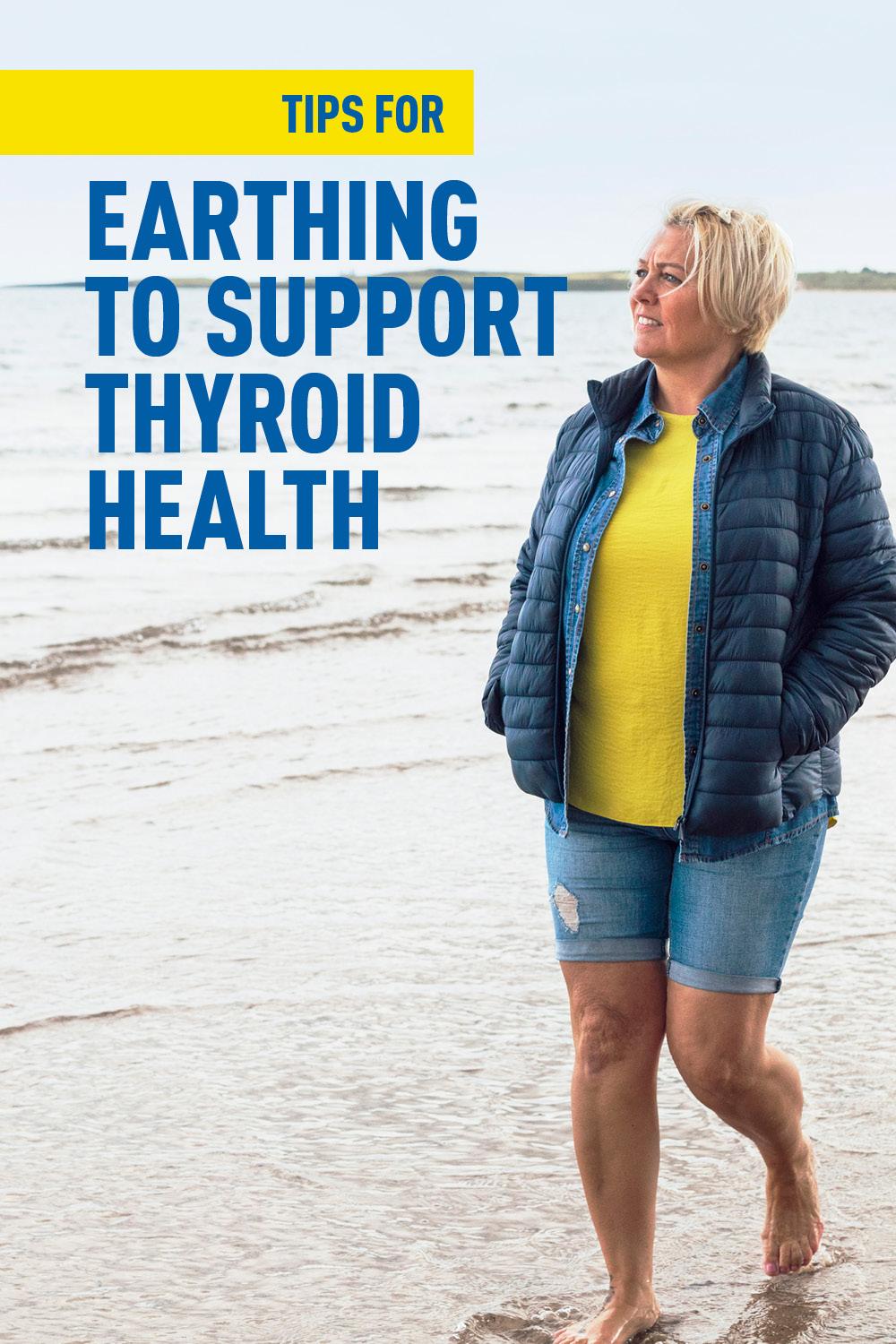Expert Advice

Acella Pharmaceuticals, LLC., is partnering with Heather Procknal, NBC-HWC-CHC, to bring greater awareness to the importance of thyroid care and education. This post is sponsored by Acella Pharmaceuticals and should not be construed as medical advice. Please talk to your doctor about your individual medical situation.
Disclaimer: The information provided is for educational purposes only and does not substitute professional medical advice. Consult a medical professional or healthcare provider before beginning any exercise, fitness, diet, or nutrition routine.
Earthing, also called grounding, is a therapeutic technique that works by realigning the body's electrical energy by connecting to the earth. There are various earthing techniques and benefits to both physical and emotional wellness. Recent research has explored earthing and its direct impact on hormones and thyroid function. If you’re interested in learning how this simple technique can help reduce your thyroid symptoms, take your shoes off and read this article outside with your bare feet touching the ground!
What is earthing or grounding?
Earthing is an easy, free, safe and simple lifestyle practice. Scientists have explored how regular contact with the earth helps stabilize the body’s bioelectrical systems.1
When the free electrons from the surface of earth pair up with damage-causing free radicals in the body, the free radicals are neutralized. This creates harmony within the ecosystem of the body.
Simply put, earthing or grounding supports the body's ability to heal itself and reduces inflammation. It does this by boosting the immune system and giving the body a readily available, natural supply of antioxidants.
How do you earth or ground yourself?
You can connect to earth outdoors just by taking off your shoes and standing barefoot on the grass. If you’re lucky enough to be close to a beach, you can walk barefoot on the sand to experience the grounding effects of the earth.
Or you can earth indoors with an earthing system that connects you to earth's free electrons while you're sleeping, relaxing or working. Earthing indoors is the easiest way to earth regularly.
Plus, you’ll find you can earth for more hours this way, which may be beneficial for chronic health issues like hypothyroidism or Hashimoto's disease.
What are the health benefits of earthing?
Earthing supports the most important pillars of health. These include good quality sleep, stress reduction, blood circulation and immune function.
A 2012 study supports these claims, stating that “... Earth’s electrons induce multiple physiological changes of clinical significance, including reduced pain, better sleep, a shift from sympathetic to parasympathetic tone in the autonomic nervous system (ANS), and a blood-thinning effect.”1
Earthing may also help to:
• Improve sleep • Reduce stress • Reduce inflammation • Reduce muscle soreness • Improve pain management • Speed healing • Improve immune response • Manage arthritis pain • Support thyroid function • Manage eczema • Reduce PMS symptoms • Improve glucose regulation
How does earthing impact the thyroid?
Earthing influences thyroid function, even in healthy people.
Researchers found that “a single night of grounding produced a significant decrease of free triiodothyronine and an increase of free thyroxine and thyroid-stimulating hormone. This result confirms an association between earthing and the immune response.”1 Earthing may be the primary factor regulating the endocrine and nervous systems.
If your thyroid is functioning better due to earthing, then you may notice a change or improvement in your thyroid symptoms over time.
Considerations regarding earthing and your thyroid medications:
Earthing can improve the physical and emotional systems of the body, which is a positive benefit. However, a byproduct of earthing could be that your medication dosage may need to be more closely monitored or adjusted.2
Before using indoor earthing products or beginning a regular earthing routine, be sure to discuss any questions or concerns with your doctor.
Outdoor earthing versus indoor earthing: which is better?
It depends on your personal preference, your environment and the amount of time you have to spend. Both outdoor and indoor earthing are beneficial, so do what works best for you.
Outdoor earthing means your body has direct contact with earth's surface, allowing the free electrons to pass into your body where they act to reduce free radical damage and inflammation.
Indoor earthing can be just as effective as an outdoor barefoot walk. Maybe even more so, as it allows for more time spent on earthing each day. Indoor earthing may be better for those with indoor professions or limited access to nature.
Generally speaking, the more hours that you earth, the greater the benefit. To some, indoor earthing is more appealing and convenient because it can be easier to soak up earth's free electrons without having to actually be outdoors. This can be helpful, especially during inclement weather or during the cold winter months.
Indoor earthing products are "fueled" by free electrons from earth's surface. These products are made of conductive materials such as silver, stainless steel or carbonized rubber that connect to a grounding lead and adapter. They work by passing free electrons from earth's surface into the product and then on to you.
While they do plug into a power outlet, they do not use any electricity or power.
How to Earth Outdoors
 Here are some easy ways you can earth outdoors on a regular basis:
Here are some easy ways you can earth outdoors on a regular basis:
- Take a barefoot walk on the beach. This is my favorite way to get grounded. For an added bonus, stroll with your feet at the water’s edge, as salt water is a great conductor and can enhance the earthing benefits.
- Sit in a chair on the beach and push your toes into the warm sand.
- Enjoy an outdoor picnic. Have your lunch outside on the grass or eat your dinner “al fresco” a few nights a week if the weather permits.
- Take a nap on the grass outside. Lay down directly on the ground and close your eyes for a few minutes. If you take off your shoes, you can experience the extra connection to earth.
- Relax and allow the stress of the day to melt away.
- Walk barefoot on unsealed concrete or brick pathways. Natural materials such as stone and slate are good conductors of earth's electrons too. The feel of organic rock walkways can be mentally soothing as you notice the various textures underfoot with each step you take.
- Gardening is a great way to connect to the earth. For best results, keep your gloves off to have direct contact with the plants and soil in the ground.
- Swim in a lake or ocean. The water is in direct contact with earth and electrons will conduct through water to your body. The weightlessness of being in the water adds to the earthing experience.
How to Earth Indoors
Here are some convenient ways you can earth indoors on a regular basis:
- Here are some convenient ways you can earth indoors on a regular basis:
- Sleep on earthing bed sheets. These sheets are usually made from organic materials such as cotton or bamboo and are lined with silver, stainless steel filament or other conductive material. The sheets are plugged into a power outlet with the bottom “ground” lead connecting to the wall, which connects to the ground outside. They also can be connected to a metal stake or rod that is inserted into earth's surface outside. Research has shown that 7 hours to 8 hours of earthing has many positive effects on overall health, so imagine how good it would feel to sleep on earthing sheets.
- Use earthing mats. These come in various shapes and sizes. They can be used at the office, on your desk while you work, or on your couch while you relax and watch TV. You could also place a mat on the floor to rest your bare feet on during the day. Being in contact with an earthing mat throughout the day can have cumulative benefits over time.
Summing it all up
It’s safe to say that being in touch with nature and earth can help improve both your emotional and physical well-being!
Whether you're an outdoorsy kind of person or more of an inside dweller, you can experience the positive effects of earthing.
Again, be sure to talk with your medical provider about your medications before beginning any type of new wellness routine. Happy earthing!

REFERENCES: 1. Chevalier, G., Sinatra, S. T., Oschman, J. L., Sokal, K., & Sokal, P. (2012). Earthing: health implications of reconnecting the human body to the earth's surface electrons. Journal of environmental and public health, 2012, 291541. https://doi.org/10.1155/2012/29154. 2. BetterEarthing.com https://betterearthing.com.au/earthing-faqs/im-thyroid-medication-earth-not/
1747-v1
INDICATIONS & IMPORTANT RISK INFORMATION INCLUDING BLACK BOX
WARNING
Important Risk Information
Drugs with thyroid hormone activity, alone or together with other therapeutic agents, have been used for the treatment of obesity. In euthyroid patients, doses within the range of daily hormonal requirements are ineffective for weight reduction. Larger doses may produce serious or even life-threatening manifestations of toxicity, particularly when given in association with sympathomimetic amines such as those used for their anorectic effects.
- NP Thyroid® is contraindicated in patients with uncorrected adrenal insufficiency, untreated thyrotoxicosis, and hypersensitivity to any component of the product.
- In the elderly and in patients with cardiovascular disease, NP Thyroid® should be used with greater caution than younger patients or those without cardiovascular disease.
- Use of NP Thyroid® in patients with diabetes mellitus or adrenal cortical insufficiency may worsen the intensity of their symptoms.
- The therapy of myxedema coma requires simultaneous administration of glucocorticoids.
- Concomitant use of NP Thyroid® with oral anticoagulants alters the sensitivity of oral anticoagulants. Prothrombin time should be closely monitored in thyroid-treated patients on oral anticoagulants.
- In infants, excessive doses of NP Thyroid® may produce craniosynostosis.
- Partial loss of hair may be experienced by children in the first few months of therapy but is usually transient.
- Adverse reactions associated with NP Thyroid® therapy are primarily those of hyperthyroidism due to therapeutic overdosage.
- Many drugs and some laboratory tests may alter the therapeutic response to NP Thyroid®. In addition, thyroid hormones and thyroid status have varied effects on the pharmacokinetics and actions of other drugs. Administer at least 4 hours before or after drugs that are known to interfere with absorption. Evaluate the need for dose adjustments when regularly administering within one hour of certain foods that may affect absorption.
- NP Thyroid® should not be discontinued during pregnancy, and hypothyroidism diagnosed during pregnancy should be promptly treated.
Indication
NP Thyroid® (thyroid tablets, USP) is a prescription medicine that is used to treat a condition called hypothyroidism from any cause, except for cases of temporary hypothyroidism, which is usually associated with an inflammation of the thyroid (thyroiditis). It is meant to replace or supplement a hormone that is usually made by your thyroid gland.
NP Thyroid® is also used in the treatment and prevention of normal functioning thyroid goiters, such as thyroid nodules, Hashimoto’s thyroiditis, multinodular goiter, and in the management of thyroid cancer.
